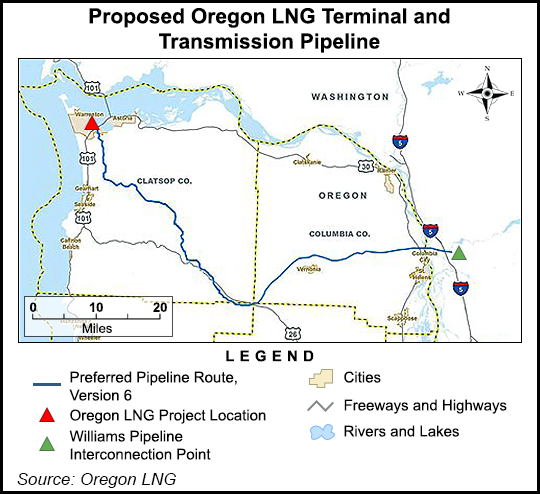LNG | NGI All News Access | NGI The Weekly Gas Market Report
Oregon LNG Gets FERC DEIS; Discounts Court Dispute Over Site Easement
A FERC draft environmental impact statement (DEIS) was released Wednesday on the liquefied natural gas (LNG) export project slated for the Columbia River in Oregon, concluding most environmental impacts can be mitigated to meet federal standards. The Federal Energy Regulatory Commission is seeking public comments on the draft by Oct. 6.

The DEIS comes at a time when the decade-old proposed project was recently hit with another potential fatal hurdle in a federal district court judge’s recommendation on a disputed easement of the site near Warrenton, OR.
While environmental groups opposing the $6.3 billion Oregon LNG project are citing the court action on a land dispute as the death knell for the project, the backers of the project contend this is untrue and they are focused now on the newly issued DEIS.
“Most of the impacts would be reduced to less-than-significant levels with the implementation of minimization and mitigation measures proposed by Oregon LNG and its interstate transmission supply pipeline, Northwest Pipeline LLC, and the additional measures recommended by the FERC staff in the draft EIS,” FERC said.
FERC staff cited nine principal factors why the project’s environmental impacts can be managed, including: Oregon LNG and Northwest will minimize impacts on natural and cultural resources; use existing Northwest pipeline right-of-way for 94% of the 86-mile pipeline project; the U.S. Coast Guard’s recommendation that the waterway would be suitable; and prior to any construction Endangered Species Act consultations would be completed with the U.S. Fish and Wildlife Service and U.S. Department of Commerce’s National Oceanic and Atmospheric Administration, and National Marine Fisheries.
The proponents of the LNG operations would not comment on the federal court case, saying their focus currently is on the DEIS.
“Oregon LNG cannot comment on this ongoing litigation except to say we are reviewing Magistrate Judge [John] Acosta’s findings/recommendations and developing a response,” said Oregon LNG Project Manager Peter Hansen. “We remain confident that this case will be appropriately resolved.”
Hansen told NGI that contrary to some media reports, the judge’s recommendation is “not a ruling, and the case is by no means settled.” Acosta’s determination and recommendations don’t have to be adopted by the court ultimately, he said. (Acosta’s recommendations were passed on to Judge Anna Brown.)
While the U.S. Army Corps of Engineers contends that it has rights to an easement on the Oregon LNG site, the judge’s ruling appears to dismiss the company challenge to those alleged rights. An attorney for Columbia Riverkeeper, which is opposed to the project and intervened in support of the Army Corps, told local news media that the more than 10-year effort to site an LNG facility at the mouth of the Columbia River could be shot down by the court.
The contention is that without the easement, Oregon LNG can’t move ahead with the project.
While dedicated local opposition groups have not lessened their campaign, backers of both Oregon LNG proposals — Warrenton and the Jordan Cove project along the south-central coast at Coos Bay, OR — have been equally resolved to see their respective permitting processes through to the end (see Daily GPI, July 3, 2014; Oct. 14, 2013).
At the center of the arguments are some submerged land on the site and an Oregon attorney general’s opinion in 1980 that the submerged lands were owned by the state and Clatsop County had no right to them. The area in question was subsequently leased by the state to the Port of Astoria, OR, in 2004 and immediately thereafter subleased to Oregon LNG.
Nevertheless, Judge Acosta’s findings sided with the Corps’ motion to dismiss Oregon LNG contentions. If the court upholds the Corps easement, Oregon LNG then asks that it be granted ingress and egress.
There are other places the project could be tripped up, including an ongoing dispute over the proposed 86-mile, 36-inch diameter transmission pipeline to supply natural gas to the proposed export facility. It is proposed to run through three Oregon counties (Clatsop, Columbia and Tillamook) and Cowlitz County, WA. Clatsop County has denied a land-use permit for a 41-mile segment of the pipeline.
Regarding the latter, Oregon LNG has contended that the county lacks the jurisdiction to hold up the pipeline; only federal authorities could do that, the company contends. The pipeline is also a big part of the DEIS.
© 2024 Natural Gas Intelligence. All rights reserved.
ISSN © 1532-1231 | ISSN © 2577-9877 | ISSN © 1532-1266 |
